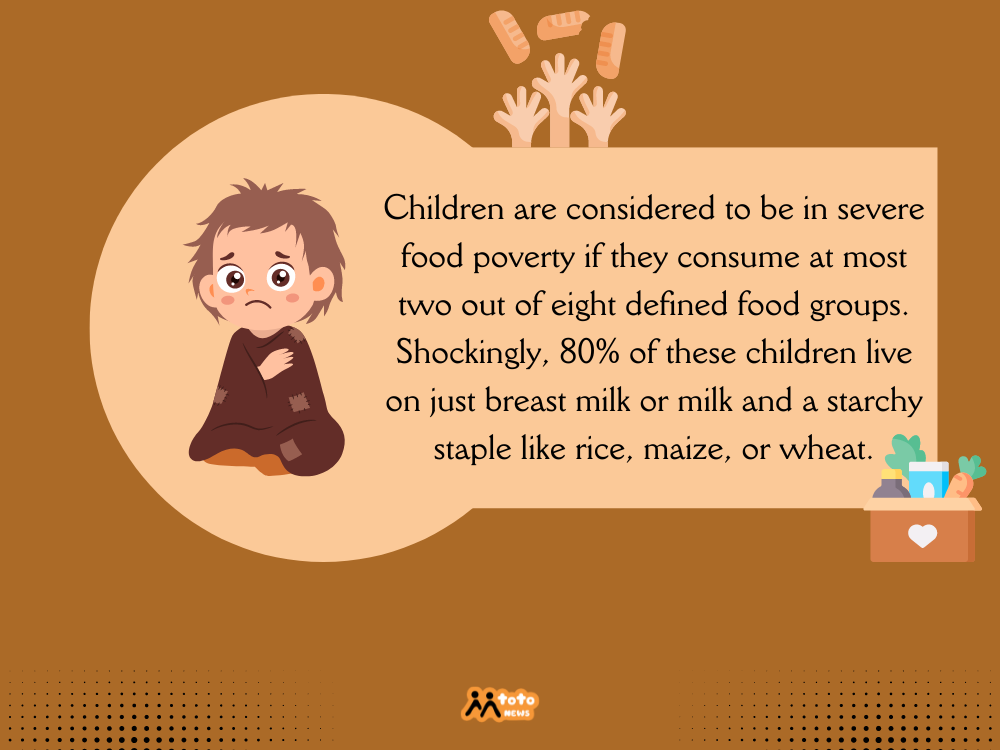A recent UNICEF report reveals that 181 million children under five, or 1 in 4 globally, suffer from severe food poverty. This makes them vulnerable to wasting, a critical form of malnutrition that threatens their survival, growth, and development.
The report, titled “Child Food Poverty: Nutrition Deprivation in Early Childhood,” analyzes the causes and effects of poor nutrition among young children in nearly 100 countries. It shows that millions of children lack access to the nutritious and varied diets essential for their growth and development.
But what is Severe Food Poverty?
Children are considered to be in severe food poverty if they consume at most two out of eight defined food groups. Shockingly, 80% of these children live on just breast milk or milk and a starchy staple like rice, maize, or wheat. Less than 10% eat fruits and vegetables, and fewer than 5% consume nutrient-rich foods such as eggs, fish, poultry, or meat.
“Children living in severe food poverty are on the brink of survival,” said UNICEF Executive Director Catherine Russell. “The reality for millions of young children is dire and can irreversibly impact their growth and brain development.”
How did we get here?
The report highlights how inequity, conflict, and the climate crisis, worsened by the socio-economic fallout from the COVID-19 pandemic, have driven food prices and living costs to unprecedented levels. This leaves millions of families unable to provide adequate nutrition for their children.
Global Impact
Of the 181 million children experiencing severe food poverty, 65% are in just 20 countries. This includes 64 million in South Asia and 59 million in Sub-Saharan Africa. In Somalia, 63% of children live in severe food poverty due to conflict, drought, and floods, with over 80% of caregivers reporting that their child had gone an entire day without eating.
In the Gaza Strip, nine out of ten children suffer from severe food poverty, surviving on two or fewer food groups per day. This highlights the devastating impact of ongoing hostilities and restrictions on humanitarian aid.
Income and Food Environment
Income poverty is a significant driver, affecting nearly half of all cases of severe child food poverty. However, 54% of affected children, or 97 million, live in relatively wealthier households where poor food environments and inadequate feeding practices contribute to the crisis.
Underlying Issues
The crisis is fueled by several factors, including failing food systems that do not provide safe and nutritious options, families’ inability to afford nutritious foods, and poor child feeding practices. Additionally, aggressive marketing of cheap, nutrient-poor, ultra-processed foods and sugary beverages displaces healthier options in children’s diets.
Despite the bleak situation, there have been successes. Burkina Faso halved its rate of severe child food poverty from 67% in 2010 to 32% in 2021. Nepal reduced its rate from 20% in 2011 to 8% in 2022, and Rwanda decreased its rate from 20% in 2010 to 12% in 2020. Peru has maintained a rate below 5% since 2014.
Call to Action
To fight child food poverty, UNICEF calls for urgent action from governments, development and humanitarian organizations, donors, civil society, and the food and beverage industry. Key recommendations include transforming food systems to make nutritious foods accessible and affordable, leveraging health systems to provide essential nutrition services, and activating social protection systems to address income poverty through responsive social transfers.
Written by Shilla Lwangu

